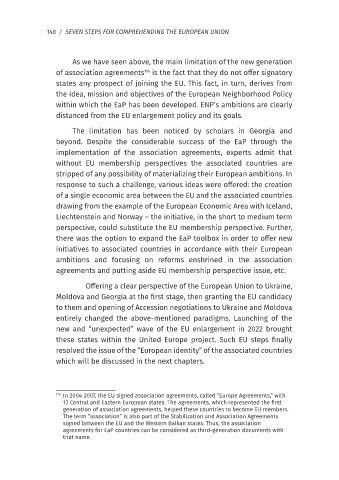Page 149 - SEVEN STEPS for COMPREHENDING the EUROPEAN UNION
P. 149
148 / SEVEN STEPS FOR COMPREHENDING THE EUROPEAN UNION
As we have seen above, the main limitation of the new generation
114
of association agreements is the fact that they do not offer signatory
states any prospect of joining the EU. This fact, in turn, derives from
the idea, mission and objectives of the European Neighborhood Policy
within which the EaP has been developed. ENP’s ambitions are clearly
distanced from the EU enlargement policy and its goals.
The limitation has been noticed by scholars in Georgia and
beyond. Despite the considerable success of the EaP through the
implementation of the association agreements, experts admit that
without EU membership perspectives the associated countries are
stripped of any possibility of materializing their European ambitions. In
response to such a challenge, various ideas were offered: the creation
of a single economic area between the EU and the associated countries
drawing from the example of the European Economic Area with Iceland,
Liechtenstein and Norway – the initiative, in the short to medium term
perspective, could substitute the EU membership perspective. Further,
there was the option to expand the EaP toolbox in order to offer new
initiatives to associated countries in accordance with their European
ambitions and focusing on reforms enshrined in the association
agreements and putting aside EU membership perspective issue, etc.
Offering a clear perspective of the European Union to Ukraine,
Moldova and Georgia at the first stage, then granting the EU candidacy
to them and opening of Accession negotiations to Ukraine and Moldova
entirely changed the above-mentioned paradigms. Launching of the
new and “unexpected” wave of the EU enlargement in 2022 brought
these states within the United Europe project. Such EU steps finally
resolved the issue of the “European identity” of the associated countries
which will be discussed in the next chapters.
114 In 2004-2007, the EU signed association agreements, called “Europe Agreements,” with
12 Central and Eastern European states. The agreements, which represented the first
generation of association agreements, helped these countries to become EU members.
The term “association” is also part of the Stabilization and Association Agreements
signed between the EU and the Western Balkan states. Thus, the association
agreements for EaP countries can be considered as third-generation documents with
that name.

